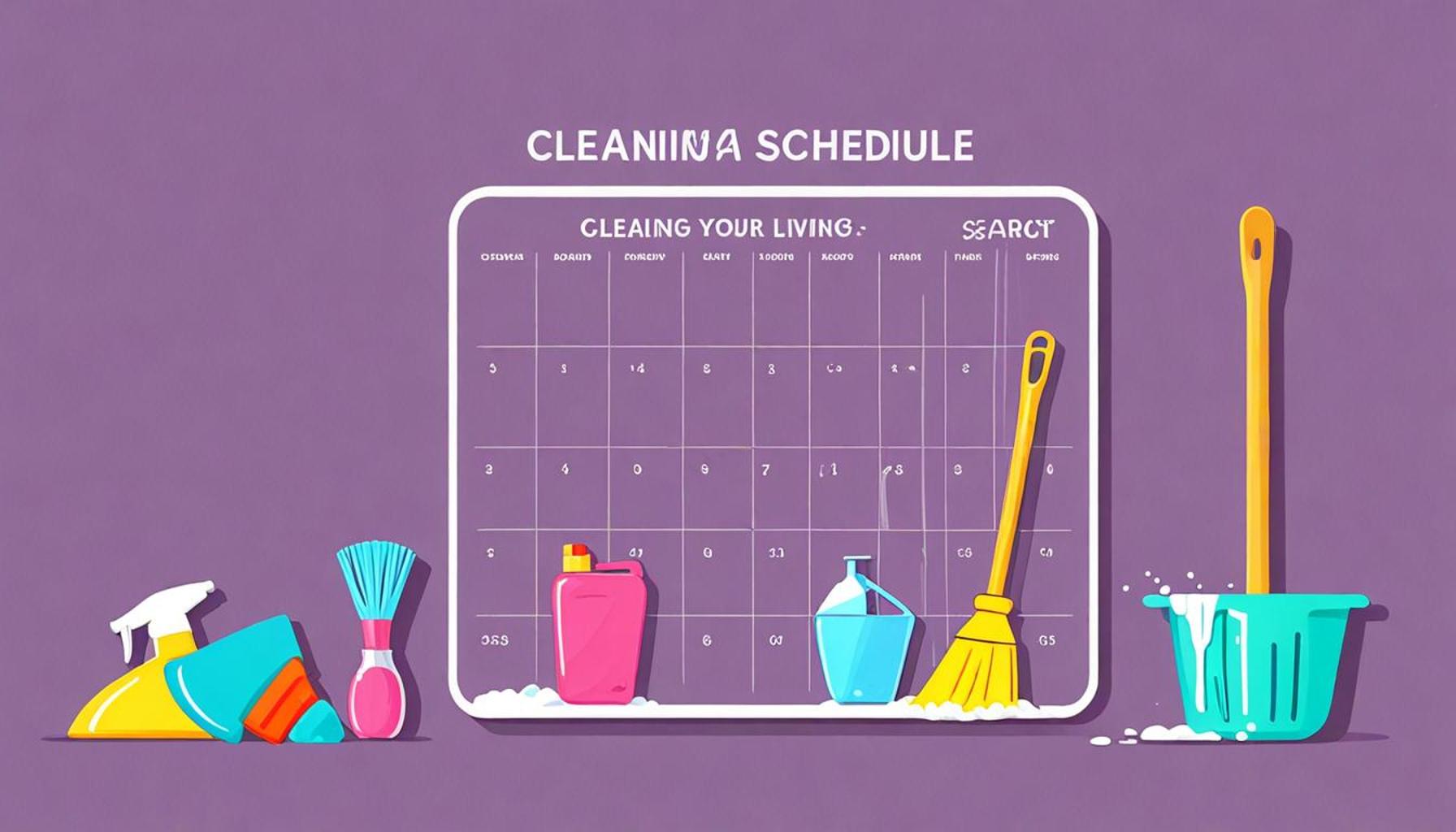How to Customize a Cleaning Schedule for Different Areas of Your Home

Creating a Customized Cleaning Schedule
Maintaining a clean home can feel overwhelming, but a well-structured cleaning schedule can make all the difference. By tailoring your approach to different areas, you can streamline your efforts and achieve a more organized living space. Here’s what you need to consider:
- Assessing Individual Areas: Each room has unique cleaning needs. The kitchen, for instance, may require daily cleaning of appliances and countertops due to food preparation, while living rooms can accumulate dust and clutter more gradually.
- Frequency of Cleaning: High-traffic areas may require daily attention, while guest rooms can be tidied less frequently. A home with pets might call for more regular vacuuming than one without, highlighting the importance of adjusting frequency based on your household’s specific circumstances.
- Seasonal Changes: Some tasks might be seasonal, such as window washing or deep cleaning carpets. In the fall, for example, you might include a task like gutter cleaning to prepare for winter, while spring could be dedicated to decluttering and organizing closets.
When customizing your cleaning schedule, think about specific tasks you need to accomplish. For instance, the kitchen might have daily chores like wiping down the stovetop after cooking or emptying the trash regularly to prevent odors. Conversely, bathrooms may require deeper weekly scrubbing of toilets and showers to maintain hygiene.
It’s also essential to involve the entire household in this process. Delegating tasks can not only reduce your own burden, but it also encourages accountability among family members. Consider these options:
- Shared Responsibilities: Create a system where everyone is assigned specific tasks, such as one person handling vacuuming while another takes care of dusting. This can effectively divide the workload, making it feel less daunting.
- Weekly Check-ins: Organize family meetings to ensure every area is maintained effectively. During these check-ins, you can discuss what worked and what didn’t, allowing for adjustments in the schedule as needed.
- Reward System: Motivate children with small rewards for completing their chores, from stickers to screen time. This incentive can turn chores into fun, manageable tasks rather than chores they dread.
With a customized cleaning schedule in place, you’ll not only improve cleanliness, but also foster a sense of pride and teamwork among residents. It’s an opportunity to teach valuable life skills and promote responsibility, ensuring that your home remains a welcoming and tidy space for everyone. Read on to discover how to design a plan that works best for you and your home.
DISCOVER MORE: Click here to learn about the future of cleaning

Identify Your Cleaning Priorities
Before diving into the specifics of your customized cleaning schedule, it’s crucial to identify your cleaning priorities. Not all areas of your home require the same level of attention or frequency, and recognizing this can help you allocate your time and resources effectively.
Start by making a checklist of each room in your house. Consider listing the primary cleaning tasks for each area. For instance, your bedrooms might include dusting furniture, washing bed linens, and vacuuming carpets. In contrast, the kitchen could require a more intense regimen including cleaning the refrigerator, disinfecting countertops, and mopping floors. This will create a clear and organized layout of what needs to be accomplished and help you visualize the cleaning scope.
Room-by-Room Breakdown
Understanding the unique cleaning requirements of each room helps ensure that no task is overlooked. Here’s a breakdown of common tasks by area:
- Kitchen: This bustling hub usually demands daily upkeep. Essential tasks include:
- Wiping down countertops and tables after meals.
- Emptying the trash and recycling bins regularly.
- Cleansing sink areas to prevent bacteria buildup.
- Checking for expired food in the refrigerator weekly.
- Bathrooms: Hygiene must take precedence here. Suggested routines include:
- Scrubbing sinks and countertops daily to avoid soap scum buildup.
- Disinfecting toilets every few days.
- Changing towels and restocking toiletries weekly for freshness.
- Deep cleaning showers or tubs to prevent mildew bi-weekly.
- Living and Dining Areas: These areas often accumulate dust and clutter, suggesting the following:
- Dusting surfaces and furniture weekly.
- Vacuuming carpets or sweeping every few days, depending on usage.
- Organizing clutter regularly, possibly on a daily basis.
- Washing any textiles like curtains or cushion covers every month.
- Bedrooms: Creating a serene and organized space includes:
- Changing bed linens and pillowcases weekly to ensure cleanliness.
- Dusting furniture surfaces and vacuuming carpets or mopping floors.
- Clearing out clutter from dressers and nightstands regularly.
This room-by-room breakdown provides a comprehensive view of what to expect, helping you prioritize tasks effectively. With each area clearly defined, you can adjust your cleaning days according to your schedule and lifestyle, ensuring that your home remains a peaceful haven rather than a source of stress.
As you design your cleaning timetable, remember that flexibility is key. Life can be unpredictable, and your schedule may need to adapt. Make it easy for yourself to swap tasks or reschedule cleaning days, turning a rigid system into a dynamic approach that fits your lifestyle seamlessly.
How to Tailor Your Cleaning Schedule for Every Space
Creating an efficient cleaning schedule requires knowing the unique needs of each area in your home. Every space serves different functions and often accumulates dirt and clutter at varying rates. To customize your cleaning schedule effectively, follow these tailored suggestions for several key areas:
The Living Room
The living room is often the heart of the home, making it essential to maintain a clean and inviting environment. Aim to dust surfaces, vacuum carpets, and clean upholstery weekly. Larger cleanups, such as deep cleaning carpets or curtains, can be scheduled monthly. This way, you’ll keep your living areas tidy for both family enjoyment and guest visits.
The Kitchen
The kitchen demands a higher frequency of cleaning due to food preparation activities. Adopt a daily cleaning routine that includes wiping down countertops and sanitizing surfaces. To ensure a healthy home, deep clean appliances, such as the refrigerator and oven, every month. A rotating schedule can help manage chores like mopping floors or organizing pantry shelves every few weeks.
The Bathroom
Due to humidity and high usage, bathrooms often require special attention. Establish a habit of daily tasks such as wiping down sinks and mirrors. Weekly deep cleans should include scrubbing toilets, shower areas, and floors to prevent mold and grime buildup. A specialized monthly schedule can involve decluttering cabinets, disposing of expired products, and refreshing towels.<h3.Bedrooms
Bedrooms can be personalized based on occupancy. For master bedrooms, consider a weekly routine that includes changing bed linens, dusting surfaces, and vacuuming. Every month, deeper tasks like organizing closets and rotating seasonal clothing will keep your space comfortable and functional. For children’s rooms, involve them in keeping their areas tidy with age-appropriate tasks each week.<h3.Home Office
In today’s environment, many have transitioned to working from home, making the home office another critical area. Establish weekly cleaning to keep surfaces organized and free from dust. Monthly tasks might include organizing files and purging unneeded paperwork, ensuring that your workspace remains conducive to productivity.Taking the time to adjust your cleaning schedule for these specific areas will not only improve cleanliness but also enhance overall living conditions within your home. With routine maintenance places, the effort you invest leads to a healthier, more enjoyable living environment.
| Category | Key Features |
|---|---|
| Living Room | Weekly dusting, surfaces and upholstery cleaning. |
| Kitchen | Daily countertop sanitation, deep clean appliances monthly. |
| Bathroom | Daily sink wipe downs, weekly showers and toilet scrubs. |
| Bedrooms | Weekly linen changes, monthly closet organization. |
| Home Office | Weekly surface organization, monthly file management. |
This specialized approach ensures that every area of your home is clean and well-maintained, enhancing overall comfort and satisfaction.
DISCOVER MORE: Click here to learn how to customize your cleaning kit
Consider Your Lifestyle and Family Dynamics
When customizing a cleaning schedule for various areas in your home, it’s crucial to take into account your lifestyle and family dynamics. Every household is unique, and what works for one family may not suit another. Understanding your specific circumstances will help you develop a cleaning routine that is both practical and sustainable.
If you have children or pets, for instance, your cleaning duties may require more frequent attention. Consider how these family members contribute to messes. For example, if you have toddlers, you might need to clean up toys and messes daily, but could delay deep-cleaning tasks until the weekends when they are less active. Similarly, if you own pets, you may find that vacuuming and lint-rolling your furniture becomes a routine necessity to manage fur and dander.
Additionally, if you work full-time or have a busy schedule, it is beneficial to create a cleaning calendar that leverages small, manageable tasks. For example, instead of devoting an entire day to cleaning, consider breaking it down into 15- or 30-minute sessions each day. An effective way to do this is to assign a specific cleaning task to each day of the week. Monday could be “bathroom deep clean day,” whereas Tuesday might be dedicated to kitchen upkeep. This segmented approach helps avoid burnout while keeping your home consistently tidy.
Leverage Technology for Efficiency
Utilizing technology can also play a significant role in streamlining your cleaning schedule. There are numerous apps and tools available that can assist in managing your cleaning obligations. For instance, calendars and task management apps can remind you when it’s time to tackle certain chores. You can even find dedicated cleaning apps that provide customizable cleaning schedules tailored to your home’s needs.
Moreover, consider robotic vacuums and smart home devices. These gadgets can automate certain cleaning tasks, allowing you to focus on other responsibilities. Many smart vacuums can be programmed to clean specific rooms on certain days, taking vacuuming off your to-do list altogether. Investing in these tools may seem daunting at first, but they can save significant time and effort in the long run.
Adjust and Adapt the Schedule as Needed
Finally, it is crucial to understand that a cleaning schedule is not set in stone. Your needs may evolve as your lifestyle changes. For example, if you transition from working in an office to working from home, you may need to revise your cleaning days and frequency. Consider block scheduling; this allows you to integrate cleaning tasks into your existing routines. For example, if you are waiting for dinner to cook, tackle a quick dusting in the living room or wipe down kitchen surfaces in between.
Encouraging family participation can also help adjust your cleaning schedule. Setting a designated family cleaning day can make chores less daunting. Assign tasks based on age and ability—children can handle tidying up their rooms, while older kids might take on bathroom or kitchen duties. This fosters a sense of teamwork and responsibility amongst family members, leading to a cleaner home environment without falling solely on one person.
Incorporating these strategies and keeping an eye on your household dynamics will ensure that your customized cleaning schedule remains not only effective but also adaptable and in sync with your family’s needs.
LEARN MORE: Click here for valuable insights
Final Thoughts on Customizing Your Cleaning Schedule
Creating a tailored cleaning schedule for different areas of your home is an empowering step towards achieving a well-organized and harmonious living space. By considering factors such as family dynamics, lifestyle, and the use of technology, you can craft a schedule that suits your specific needs while promoting efficiency.
As you embrace this process, remember to prioritize flexibility. Life changes, whether due to new family members, work schedules, or personal commitments, may require adjustments to your routine. By integrating small, manageable tasks into your everyday activities, you can maintain a cleaner home without feeling overwhelmed.
Moreover, the importance of collaboration cannot be overstated. Involving family members in your cleaning schedule not only distributes the workload but also cultivates a sense of responsibility and teamwork. Whether it’s establishing a family cleaning day or assigning age-appropriate tasks, a united effort can make cleaning less burdensome.
As you reflect on your specific home environment, don’t hesitate to experiment and adapt your cleaning strategy until you find what works best for you and your household. Remember, a customized cleaning schedule is more than just a list of chores—it’s a pathway to a more organized lifestyle that enhances your overall quality of life. Explore different methods, stay consistent, and enjoy the benefits of a cleaner, more welcoming home.


